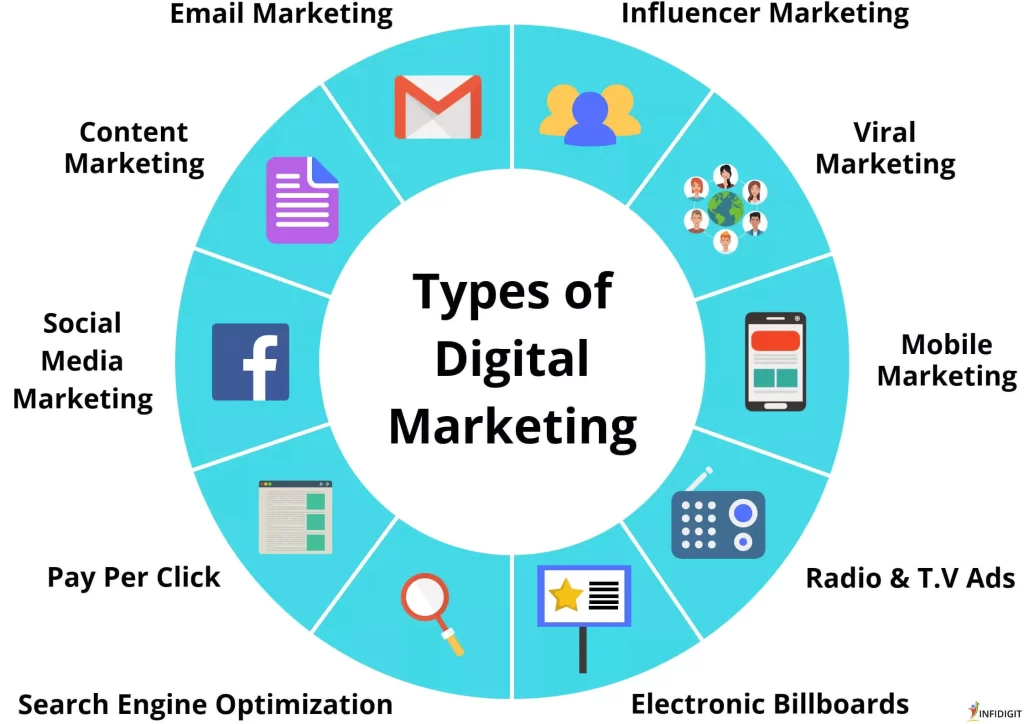Table of Contents
ToggleI. Understanding Digital Marketing
A. Definition of Digital Marketing
What constitutes digital marketing?
The evolution of marketing in the digital age.
Key differences between traditional and digital marketing.
B. Importance of Digital Marketing
Reach and engagement in the online space.
Cost-effectiveness compared to traditional marketing.
The role of digital marketing in brand awareness.
C. Key Components of Digital Marketing
Overview of various channels (SEO, content, social media, etc.).
Integration of online and offline marketing strategies.
The role of data and analytics in digital marketing.

II. Core Digital Marketing Strategies
A. Search Engine Optimization (SEO)
Understanding search engines and algorithms.
On-page and off-page SEO techniques.
Importance of keyword research and usage.
B. Content Marketing
Different forms of content (blogs, videos, infographics).
The importance of storytelling in content marketing.
Measuring the effectiveness of content strategies.
C. Social Media Marketing
Overview of popular social media platforms.
Strategies for increasing engagement and audience growth.
Best practices for content sharing and posting frequency.

III. Digital Advertising Techniques
A. Pay-Per-Click (PPC) Advertising
Explanation of how PPC works.
Pros and cons of PPC advertising.
Tips for creating effective ad campaigns.
B. Social Media Advertising
Paid promotional options on various social media platforms.
Targeting and retargeting strategies.
Ad formats and their effectiveness.
C. Display Advertising
Understanding display ads and where they appear.
Designing visually appealing and effective banners.
Measuring ROI and conversions from display a
IV. Tools and Technologies
A. Analytics Tools
Overview of tools for website analytics (Google Analytics, etc.).
Importance of tracking user behavior and conversion rates.
How to leverage data for strategy adjustments.
B. Email Marketing Software
Key features to look for in email marketing tools.
Strategies for building effective email campaigns.
Importance of list segmentation and personalization.
C. Social Media Management Tools
Comparing popular social media management platforms.
Features for scheduling, monitoring, and engagement.
Analyzing social media performance metrics.

V. Future Trends
A. Artificial Intelligence and Automation
How AI is transforming digital marketing strategies.
Examples of tools that utilize AI for marketing.
The pros and cons of automation
B. Voice Search and Smart Assistants
The impact of voice search on SEO strategies.
Optimizing content for voice-activated technologies.
Predictions for the future of voice search marketing.
C. Personalization and Consumer Experience
Importance of personalized marketing in modern approaches.
Tools and techniques for personalizing user experiences.
The balance between personalization and privacy concerns.
VI.Optimize for Search Engines (SEO)
- Keyword research: Identify relevant keywords with high search volume and low competition.
- On-page SEO: Optimize title tags, meta descriptions, headings, image alt text, and internal/external links.
- Technical SEO: Ensure your website is mobile-friendly, has fast loading speed, and is free of broken links.
VII.Define Your Goals & Target Audience
- What do you want to achieve with your blog? (Increase brand awareness? Generate leads? Drive sales?)
- Who are you writing for? (Demographics, interests, pain points, online behavior)
VIII.Create High-Quality, Engaging Content
- Write in a clear, concise, and engaging style.
- Use visuals to break up text and enhance readability.
- Incorporate storytelling and personal anecdotes.
- Proofread carefully to avoid any errors.
IX.Promote Your Blog Posts
- Share on social media platforms: Utilize relevant hashtags and engage with your audience.
- Email marketing: Send out newsletters featuring your latest blog posts.
- Paid advertising: Consider running targeted ads on social media or search engines.
- Guest blogging: Contribute to other relevant blogs to reach a wider audience.
X.Analyze & Track Your Results
- Use Google Analytics to track website traffic and user behavior.
- Monitor social media engagement and website conversions.
- Analyze your blog post performance and identify areas for improvement.
- Regularly adjust your strategy based on your findings.
XI.Tools to Help You:
- Google Analytics: Track website traffic and user behavior.
- Google Search Console: Monitor your website’s search performance.
- SEMrush, Ahrefs: Keyword research and competitor analysis tools.
- Canva, Adobe Spark: Create visually appealing graphics.
- Grammarly: Proofread and improve your writing.
